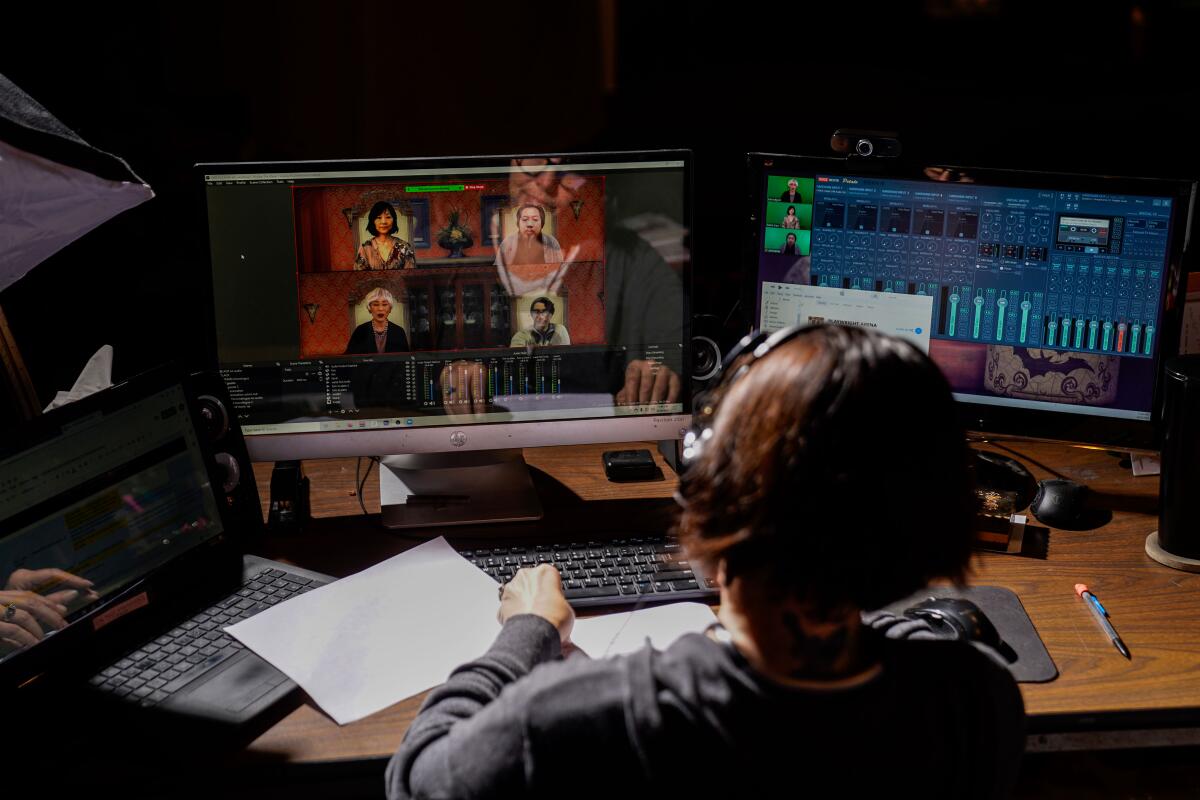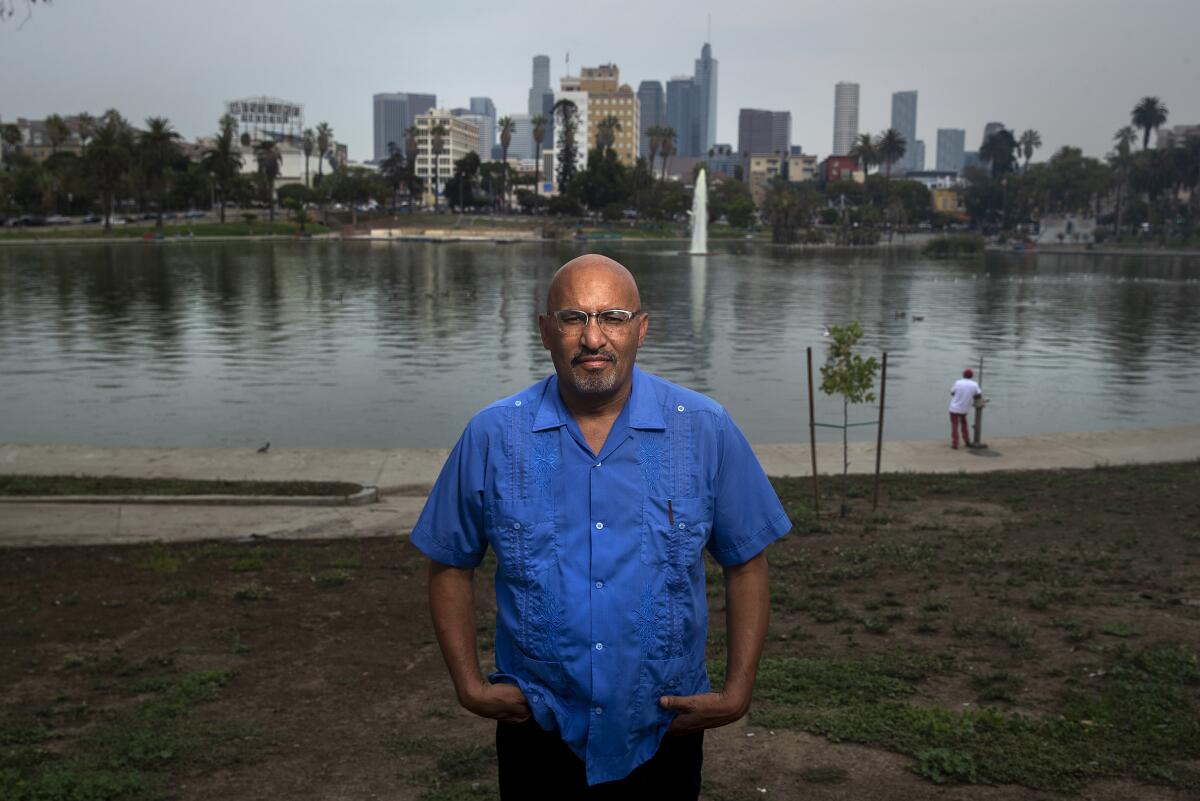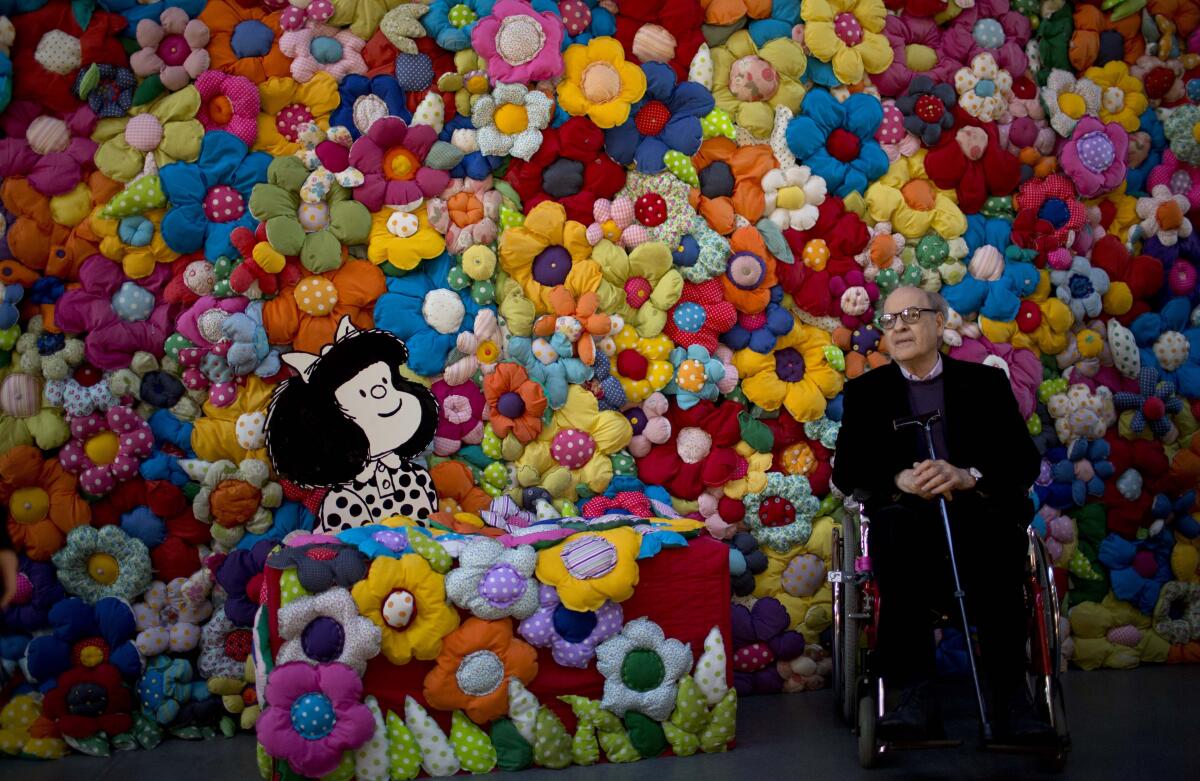Essential Arts: The short, bright life of L.A. painter Carlos Almaraz in new Netflix doc
As I write this, we are exactly two days into October and it is already full of surprises. I’m Carolina A. Miranda, staff writer at the Los Angeles Times, with the week’s essential culture news — and escapist Instagram accounts.
Art on the screen
It seems right in one pandemic to consider the life of an artist felled by another: Carlos Almaraz, the Mexico City-born, L.A.-raised painter whose expressionistic canvases of fiery car crashes found strange beauty in destruction and in L.A.’s indifferent, industrial landscapes. Almaraz died in 1989 at the age of 48 from AIDS-related complications. But his paintings have remained vital to the ways in which Los Angeles sees itself.
For the record:
2:50 p.m. Oct. 5, 2020An earlier version of this newsletter listed a review by Carol Cheh as having been published by KCET’s “Artbound.” It was published by KCET’s “Southland Sessions.”
The artist, who was the subject of a major retrospective at the Los Angeles County Museum of Art in 2017, is now at the heart of a new documentary, “Carlos Almaraz: Playing With Fire,” directed by Elsa Flores Almaraz, a painter who is also Almaraz’s widow, and actor and filmmaker Richard Montoya, a founding member of the theater troupe Culture Clash.
The 85-minute doc landed on Netflix this week and it’s a loving paean to an energetic painter who served as a locus of L.A.’s Chicano cultural scene. Yet it doesn’t shy away from Almaraz’s troubled periods, including the sexual abuse he suffered at the hands of an uncle, the struggles he had as a young man reckoning with his bisexuality and his bouts of excessive drinking.
Make the most of L.A.
Get our guide to events and happenings in the SoCal arts scene. In your inbox once a week.
You may occasionally receive promotional content from the Los Angeles Times.
The film features the bigwigs of the Chicano-gentsia — Edward James Olmos, Cheech Marin, Dolores Huerta — all commenting on his work and the time.
But it is at its best when focused on Almaraz and his work — examining how theater inspired his painting; how he infused chilly, grid-based minimalism with his own more buoyant language; and how in the activist-minded 1970s he sought a new way of working with Los Four, the collective that included painters Frank Romero, Gilbert “Magú” Lujan and Beto de la Rocha. (A curious omission from the film: painter and muralist Judithe Hernandez, who joined Los Four after it had formed.)
A wealth of archival video interviews with Almaraz, as well as access to his journals give the documentary an intimate touch — as does footage of the artist late in life, when AIDS had devoured his vigor. Ultimately, it’s a compelling tribute to an artist who lived fast and died young. But who left behind a rich visual legacy that was as informed by art history as it was by the singular landscapes of Los Angeles.
Coronavirus and the arts
In L.A., small theaters have banded together into a new group, Alternative Theatre Los Angeles. Its first public event, “Together L.A.,” is an online festival of 10-minute plays that debuted this week and continues through Oct. 17. The Times’ Daryl H. Miller reports that actors filmed their performances at home; engineers then edited them together at home, sending “the message that not only is theater still being made, but it continues to innovate.”

Theater critic Charles McNulty reports on how these small theaters have been dealing with the devastation of remaining closed for seven months. “The festival is proof that something positive has emerged from an unprecedented crisis,” he writes. “With mutual survival on the line, L.A.’s network of small theaters has strengthened its communal bonds, pooling resources and ingenuity and setting aside (at least for the time being) competition.”
The Center Theatre Group is also pivoting to digital. In addition to the Ahmanson, the Mark Taper and the Kirk Douglas, L.A.’s largest nonprofit theater company this week announced the creation of its newest venue: the Digital Stage, and artistic director Michael Ritchie tells The Times’ Jessica Gelt that he would like to make it a permanent offering. Content will be produced by a newly formed group of theater artists dubbed the CTG Creative Collective.
Contributor Catherine Womack tells the story of a collection of violins belonging to Jewish musicians that somehow survived World War II. These were to be played in a concert at the Soraya in March, then go on display at the Holocaust Museum Los Angeles. The pandemic, however, put an end to that plan. Last week, they were flown back to Tel Aviv — but not before a group of L.A. musicians got to play them.
For the first time in 42 years, the Pritzker Prize ceremony will not be held in person. Instead, the prize’s organizers will be debuting a documentary-style video in honor of winners Yvonne Farrell and Shelley McNamara.
Classical notes
Times classical music critic Mark Swed has been digging into “Wagnerism: Art and Politics in the Shadow of Music,” New Yorker writer Alex Ross’ 784-page tome devoted to the wildly influential and wildly complex German composer — a “poisonous” anti-Semite whose music has moved and influenced many. “Underscoring Wagner’s pervasive influence on culture and society, Ross makes his subject less Wagner himself — although he has plenty to say about the problematical man,” writes Swed, “than the way we absorb ideas and attitudes, how they can grow into cancers or panaceas.”
Swed also continues his series on listening with a piece about composer Toru Takemitsu’s “November Steps,” a commission for the New York Philharmonic that premiered in 1967 and featured both Western and traditional Japanese instrumentation. But this is no work of “palatable musical fusion,” writes Swed. Instead, it is a “strange and radical work,” a “dialogue that is no dialogue at all.”
Find Swed’s entire series here.
About art
Walter and Louise Arensberg were important L.A. collectors who mixed pre-Columbian sculptures with works by L.A. painters such as Knud Merrild with international figures such as Marcel Duchamp and Diego Rivera. A new book by Getty Publications, “Hollywood Arensberg: Avant-Garde Collecting in Midcentury L.A.,” catalogs that collection — down to the ways in which those works were arranged in their home. Times art critic Christopher Knight has a look at what these arrangements and this “captivating book” reveal about art and artists in L.A. in the 20th century.
In Santa Monica, Mark Steven Greenfield has a solo show on view at William Turner Gallery that finds fresh ways to interpret the image of the Black Madonna. In Greenfield’s hands, these maternal figures become contemporary icons that help vanquish white supremacy. “I was taking those classical paintings by Bellini and Raphael and Da Vinci, and I was Black-ifying them,” Greenfield tells me.
Carol Cheh reviews the show for KCET’s “Southland Sessions.” The works, she writes, “hold complicated visions — visions of Black perseverance and Black love in the face of unspeakable evil, visions of compassion even toward your worst enemy, visions of a future filled with more Black joy as white supremacy finally recedes into the background.”
Getting the band together
Times culture reporter Ashley Lee goes behind the scenes on the filming of “The Boys in the Band,” the new film version on Netflix of Mart Crowley’s 1968 play, directed by Joe Mantello. Judy Becker, the film’s production designer, talks about the apartment set in which much of the action takes place and what it reveals about Michael, a character who is “perpetuating a delusion of aspiration and fabulousness to the point that it’s practically encroaching him.” Lee also looks at the film’s slightly revised ending. So ... spoiler alert!
LACMA on my mind
Tom Christie, former arts editor at L.A. Weekly, in an op-ed for The Times, wonders what the deal is with all the carping about Peter Zumthor’s design, describing the old buildings as “pedestrian, vertical, confining.” He writes: “My bet, and I believe a safe one, is that these high-functioning professionals have in fact got this, down to the door handles, and that the result will be as promised: sublime.”
Architecture writer Joseph Giovannini, however, says there is good reason to carp. “There are two demolitions going on at the Los Angeles County Museum of Art,” he writes in the New York Review of Books. “Over the last several months, the museum has razed three of the four structures on the East Campus ... The second is the demolition of the museum’s very mission.”
Enjoying this newsletter? Consider subscribing to the Los Angeles Times
Your support helps us deliver the news that matters most. Become a subscriber.
LACMA director Michael Govan’s house is getting downsized. I report on the sale of the 5,100-square-foot, Tudor-style home, owned by the museum, which is provided as a perk of employment. It is now on the market for a cool $6.575 million.
On the art front: LACMA has teamed up with the Vincent Price Art Museum to acquire works by the late photographer Laura Aguilar and multidisciplinary artist rafa esparza — including a stirring painting on adobe that was shown at MASS MoCA last year. (I wrote about that installation then.)
An act of remembrance
The Times’ Daniel Hernandez profiles Roberto Lovato, author of “Unforgetting: A Memoir of Family, Migration, Gangs, and Revolution in the Americas,” about how he aims to bring nuance to depictions of the Salvadoran experience in the U.S. “Forgetting begets forgetting,” he writes in the book, and “begets ongoing mass murder.”

Lovato also writes a piece for the San Francisco Chronicle about what it means to read Joan Didion’s “Salvador” as a Salvadoran.
Essential happenings
Matt Cooper rounds up the happenings both virtual and IRL. On the digital front, that includes a new video work by performance artist and Black Lives Matter co-founder Patrisse Cullors, which is premiering on the REDCAT website on Saturday. And his list of in-person events include a series of walk-up and drive-up performances staged by the Heidi Duckler Dance company, which is celebrating its 35th anniversary.
Plus, on Monday, PBS’ “POV” series is screening Alex Rivera and Cristina Ibarra’s hybrid docu-feature about immigration activists who get themselves arrested as a way of investigating conditions inside a for-profit immigration prison. In his review of the film, published in May, Times film writer Mark Olsen commended the film’s “audacity” and “unrestrained boldness.”
Passages
Joaquín Salvador Lavado, the Argentinean cartoonist universally known as Quino, whose comic strip about a politically minded little girl named Mafalda, has died at 88. Lavado’s obit in the Spanish daily El País reported that the cartoonist, beloved all over Latin America and in Spain, was once asked in private what would have become of that little girl today. He responded that “she would probably be dead because she would have been disappeared by the Argentinean military.”

This week, I’m pouring one out for Quino. Mafalda, a girl prone to asking many, many questions, has served as my social media avatar for years.
In other news
— The Flora L. Thornton Foundation, an L.A.-based nonprofit known for its support of cultural causes, also supports anti-immigration organizations, according to a new report by Lexis-Olivier Ray in L.A. Taco.
— San Francisco Chronicle critic Joshua Kosman looks at what can be done to contend with opera’s Orientalist tendencies.
— The Los Angeles Chamber Orchestra is going virtual for its 2021-21 season, with 16 episodes directed by artist and designer James Darrah.
— Ballet dancer Misty Copeland has a new children’s book about how she came to be a dancer called “Bunheads.”
— A cancellation of a traveling retrospective of the work of Philip Guston has generated outrage among artists, curators and critics. Writer Martha Schwendener examines Guston’s artistic legacy.
— Since 2018, Andres Serrano has been collecting hundreds of President Trump-related objects. Now he has gathered them into a book titled “The Game: All Things Trump.”
— David Adjaye, the architect behind the Smithsonian’s National Museum of African American History and Culture in Washington, D.C., is the recipient of the RIBA Royal Gold Medal.
— Landscape designer Mia Lehrer, founder of Studio MLA, is joining the design team for billionaire Nicolas Berggruen’s mountaintop think tank, the Berggruen Institute.
— This 2018 episode of “Reply All,” about the likely origins of QAnon, is a must-listen.
And last but not least ...
Because we could all use some escapism: “Accidentally Wes Anderson.”
The biggest entertainment stories
Get our big stories about Hollywood, film, television, music, arts, culture and more right in your inbox as soon as they publish.
You may occasionally receive promotional content from the Los Angeles Times.




